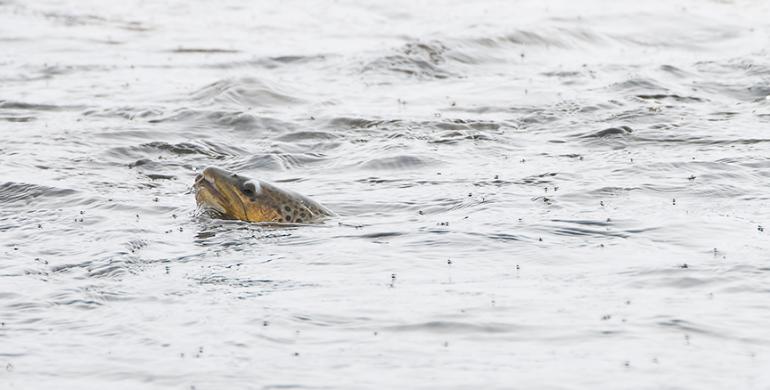Stay on Top
An argument for dry-fly fishing
When I was young and learning to fly fish with my ever-patient grandfather, I asked him why we had to fly fish. He had been kind until then, but the thread was wearing thin and he hesitated answering. He looked past me into the smooth run we were fishing. I followed his gaze and noticed a dozen trout noses gently nudging through the surface rising to little brown mayflies along the far bank. Without turning his eyes from the gilded prize, he said, “This is why we fly fish.”
He told me to wind in my line and watch for a bit. The fly on his leader landed above the trout feeding closest to us after a soft, lovely cast. The little March brown dry fly drifted a few inches and was met with the nose of a brown trout and the fight was on. Soon enough, the gleaming trout was in the net and flopping in the creel. He dried the fly and soon another fish was throbbing on the end of the line.
He caught seven fish in a row and called it a day. The bugs were done and the pool was at peace again. Walking back to the cabin in the failing light he reminded me that it wasn’t simply important to catch fish, but to master the process with tackle that demanded skills learned over time.
Today, with advanced understanding of aquatic insects, perfected tackle, fabulous watercraft, exacting flies, fluorocarbon leaders, the Internet, this magazine, professional guides, and high-speed travel, the catching of fish is more efficient than ever before. But we choose fly fishing because it is a challenge. Bait generally works better at bending the rod, but flies are devoted to the deception and trickery that plucks at our imagination and calls for focus.
Last fall, while wading one of Montana’s big tailwaters, the trout were rising as far as I could see on a dark caddis along the bank. I cast for four hours and caught very nice trout on dries within sight of the giant dam, while dozens of guided drift boats and rafts floated by. They were all following more or less the same path in the deepest part of the river with indicators and deep nymph setups. I couldn’t help but wonder why these anglers weren’t casting dry flies to these surface-feeding fish.
From a guide’s perspective, getting clients into fish has become the measure of success—and the bobber, shot, and nymph set up has become the tool of choice. Most guides I know would relish an opportunity to dry-fly fish if asked, and are great casting and fly-fishing teachers who will do their level best to stick a few on dries. But it requires anglers to elevate their skill set, sharpen their eyes, and perfect their casts to fool the trout.
So why fly fish? It’s about making the game challenging and as visually entertaining as possible by fishing a dry fly—catching fish on a fly you can see. Either way, we fly fish to be where the fish live, and connect with them and their space—not just to catch them.
David Decker owns the Complete Fly Fisher lodge on the banks of the Big Hole River.












